CIES Football Observatory Monthly Report
Issue no. 12 - February 2016
Foreign players in football teams
Drs Raffaele Poli, Loïc Ravenel and Roger Besson
1. Introduction
The proportion of foreign players in professional football teams has increased steadily over the last thirty years. This progression has been particularly strong in Europe after the intertwining of legal and economic criteria. The 1995 “Bosman” ruling has strongly weakened the quota regime that was in force at the time, while the development of football as part of the entertainment industry, with the notable introduction of pay television, has allowed most clubs to increase their revenues and widen the scope of their recruitment.
Up until 1985, the percentage of imported players in squads of teams in the five major European leagues never exceeded 10%. From that date onwards, the proportion of players has grown continuously. The biggest increase was observed between 1995/96, the last season before the “Bosman” ruling came into force, and 2000/01: from 18.6% to 35.6%. This growth has continued to this day although at a lesser rate.
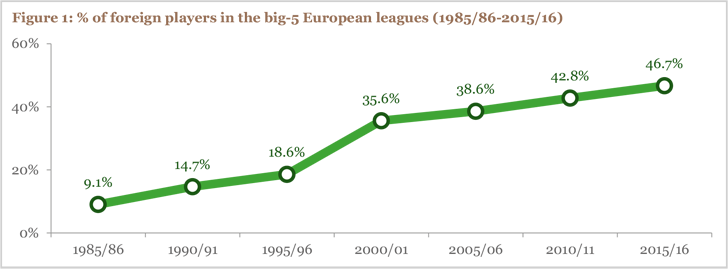
What is the situation today in leagues worldwide? This report analyses the presence of foreign footballers in the top division championships of 37 countries: 12 European, 12 Asian, 12 Latin American and one from the United States*. Within each zone, the leagues have been chosen according to their competitiveness.
[*Asia: Australia, China PR, Iran, Iraq, Japan, Korea Republic, Qatar, Saudi Arabia, Thailand, United Arab Emirates, Uzbekistan and Vietnam; Europe: Belgium, England, France, Germany, Italy, Netherlands, Portugal, Russia, Spain, Switzerland, Turkey and Ukraine; Latin America: Argentina, Bolivia, Brazil, Chile, Colombia, Costa Rica, Ecuador, Mexico, Paraguay, Peru, Uruguay and Venezuela; United States: MLS.]
The data refers to players present in squads in December 2015 having played championship matches since the beginning of the ongoing season or that which had just finished.
2. Foreign players in the best leagues worldwide
Foreigners represent 26.6% of players in the 37 leagues analysed. European and American MLS teams are by far those who recruit the most from abroad. Within these leagues, almost half of the players have a foreign origin. This proportion is significantly lower in both Asia and Latin America.
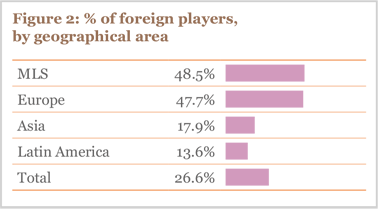
The relatively low percentage measured in Asia is explained by quotas strongly limiting the presence of foreign players in teams. These limitations are aimed at allowing national footballers to play for the best teams in the country. Without such quotas, Asian clubs would certainly import more players to make up their squads. While the existence of limitations on foreigners is advantageous in this sense, the real issue for the development of Asian football over the long term lies in the ability of clubs, leagues and national associations to improve the standard of training given to local talents.
The stakes are of a different nature in Latin America. In contrast to Asia, football historically is king in Latin America. This continent plays a primordial role in the export of players to the four corners of the world. Latin American teams do not hesitate to give local footballers their chance in order to transfer them abroad for money. The principle task for Latin America is to pursue its efforts in training to be able to deal with the increasing competition in this area, while limiting the degree of speculation around young players so as to encourage the fostering of more talent.
Finally, for most of the European leagues analysed and the American MLS, the central concern is to recognise the importance of having home-grown players in top division teams of the country. The easy choice may indeed push more and more clubs to abandon all efforts regarding training. This would actually weaken clubs as territorially embedded institutions to the advantage of other teams and the numerous intermediaries active on the transfer market.
Generally speaking, foreign footballers in the leagues analysed are slightly older than national players: 27.1 years of age compared to 25.7. While only 13.2% of footballers under 21 are foreigners, the latter represent 33.8% of players over 28 years of age. In the majority of cases, footballers start their career in their country of birth and do not move abroad until having proved their talent in professional national clubs. Nevertheless, the average age of first migration tends to diminish in relationship with the international recruitment of a greater number of very young players.
Analysis according to position shows that the highest percentage of foreign players is to be found among forwards: 34.9%. By contrast, only one goalkeeper in five is from abroad: 20.5%. This proportion is about one in four for defenders and midfielders. When it comes to recruiting abroad, clubs tend to focus on forwards. Consequently, given equal experience or value, a forward can move abroad more easily than footballers playing in other positions.

3. Foreign players in Latin America
The lowest foreign presence among the Latin American leagues studied was measured in Brazil. This is related to the great footballing tradition of this country and its key role in the exportation of players. In this context, Brazilian clubs prefer to give opportunities to local footballers rather than import them from abroad. The proportion of players imported is also less than 10% in the second biggest exporter of South America, Argentina, as well as in five other countries. Conversely, the highest percentage was measured in Mexico, a country where clubs have considerable financial means.
The percentage of foreign players in Latin America does not exceed 20% for any of the positions taken into account, varying between 10.9% for defenders and 19.1% for forwards. On average, foreign footballers are much more experienced than nationals: 28.5 years of age compared to 25.3. This is the biggest gap observed for the zones analysed. This finding suggests that foreigners in Latin America are mostly recruited from a result perspective and not with a view to generating revenues on the transfer market.
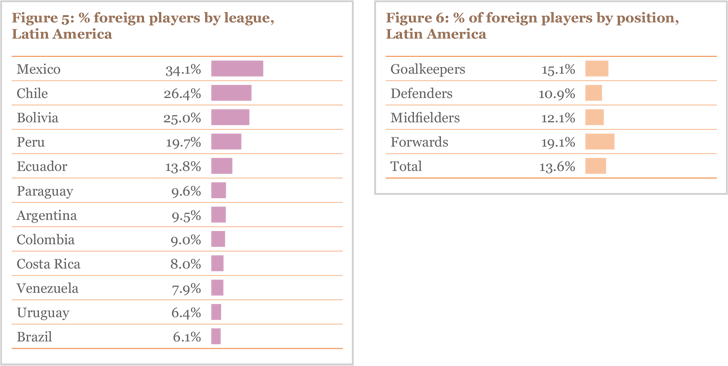
4. Foreign players in Asia
In ten of the 12 Asian championships included in this study, the proportion of foreigners is situated between one tenth and a fifth of squads. The proportion of imported players was over 30% in only two countries: Australia and Qatar. The strong international outlook of the Qatari league in comparison to the other Asian championships studied has not prevented the local managers from setting up an ambitious training programme within the Aspire Academy. This top level sporting centre brings together experts from all over the world with the aim of training players for the 2022 World Cup national team.
There are large disparities in the percentage of foreign footballers according to the position examined. As in the other zones analysed, the relatively greater presence of foreign players was measured for forwards: 31.1%. In a context where quotas strongly limit the import of footballers, Asian clubs tend to concentrate their international recruitment on forwards even more than top division teams from other continents. Similar to Latin America, foreigners are considerably older than nationals: 28.5 years of age as opposed to 26.6. In Asia too, the import of players does not aim primarily to make profits on the transfer market.
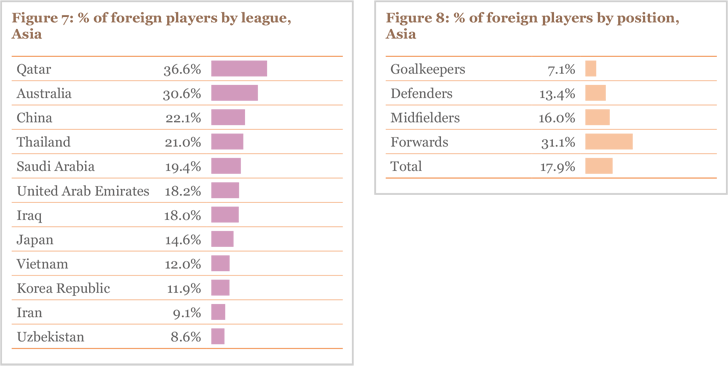
5. Foreign players in Europe
None of the European leagues surveyed has a proportion of foreigners lower than one fifth. In six cases out of twelve, this percentage is over 50%. The highest value was measured for the English Premier League: 66.4%. Foreign players represent an important part of squads throughout Europe. The significantly lower figure measured in Ukraine is partly due to the conflict with Russia. The relatively low percentages observed in France, the Netherlands and Spain are a reflection of the importance given to training in these countries, as well as of the expertise existing in this field.
Foreigners represent at least 40% of players regardless of position. As elsewhere, the highest relative presence was measured for forwards. More than half of forwards in European leagues included in the study are of foreign origin (55.2%). The average age of foreign footballers is close to that of nationals: 26.1 years of age compared to 25.5. Being very numerous, imported players no longer have any particular status within teams of the most competitive leagues of the Old Continent.
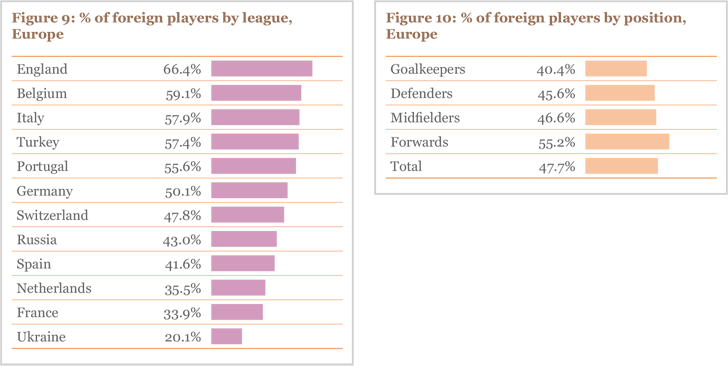
6. Foreign players in the MLS
During the 2015 season, foreigners represented almost half of the players in MLS teams. Their distribution between clubs was relatively homogenous. Only three teams had less than 10 imported players: New England Revolution, DC United and Toronto FC. The numerous American players in the latter team were not considered as foreigners. By contrast, Vancouver Whitecaps, Orlando City and Seattle Sounders had the highest contingent of foreign footballers.
As in the other zones, foreign players are over-represented among forwards: 60.9%. By contrast, only 15% of goalkeepers of MLS teams were imported. This result reflects the important tradition of goalkeeper training in the United States. Numerous American goalkeepers are active abroad.
The average age of foreigners does not differ greatly to that of nationals: 27.4 years of age compared to 26.3. This finding illustrates that the MLS regroups relatively seasoned players in comparison with the European and Latin American top division leagues surveyed.
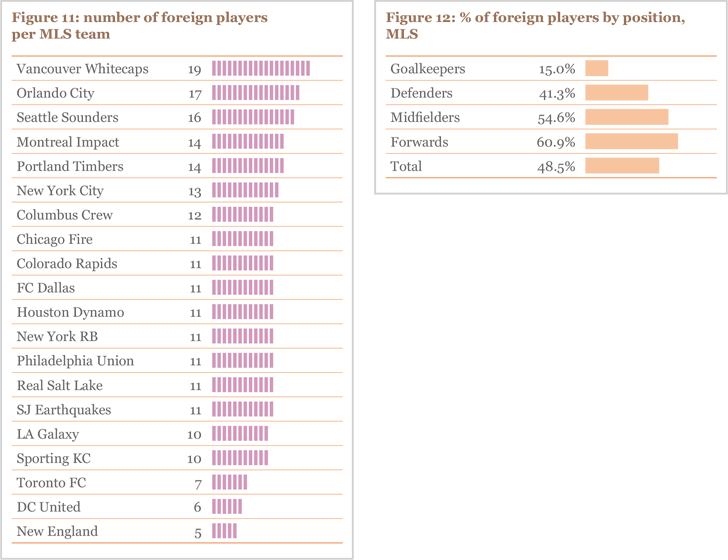
7. International mobility: what’s really at stake
Throughout the history of football, foreign footballers have always enjoyed a privileged status within teams. The existence of quotas strictly limiting their presence has obliged clubs to orientate their international recruitment towards experienced players. The latter were generally among the best footballers of the squad and became as a result favourites in the public eye. This situation has changed considerably today, especially in Europe.
The weakening of quotas in Europe has led to a multiplication of international flows. For most countries, the qualitative assessment of the exchange between players imported and players exported is henceforth negative. The main beneficiaries of the liberalisation of flows are the top clubs of the most financially powerful leagues. These dominant teams can indeed concentrate talent even more strongly than in the past. This process is at the heart of the deterioration of the competitive balance in Europe.
Being in a financial position to recruit the best players regardless of their origin can however be a trap. All the clubs having left their mark on modern football in Europe (Real Madrid, Ajax, Bayern Munich, Milan, Manchester United) and elsewhere (Boca Juniors, River Plate, Santos, Flamengo) had several home-grown pillars, whose presence made a major contribution to their legendary status. The most recent example is Barcelona.
The recruitment of a plethora of foreign players to the detriment of local or national ones can also mask outrageous short-term speculation on the transfer market. This tends to undermine clubs’ future. Within the framework of these policies, foreign players are not recruited as elements to bolster teams in the long term but rather to showcase and transfer them for profit. These transactions often benefit actors that are part of the transfer networks even more than the employer clubs.
The underlying financial stakes of transfers in general, and in international transfers in particular, tend to undermine local footballers. Indeed, the latter are less interesting from a commercial perspective as they are already available in-house. The imbalance between local and imported players, compounded by poor results, can result in weakening the club’s role as a means of identifying with a given town or territory, as well as in a loss of support from fans. Within this context, as in the domain of migration in general, the foreigner can become a scapegoat for the public to vent their anger upon.
Consequently, it is of the upmost importance that football governing bodies and the state authorities work together to limit shady transfer arrangements, especially on an international level. It is also important to change mentalities within clubs of all levels so as the training of local talents is considered as worthwhile long term investment and not just seen as an additional constraint or as social work to “sell” to local authorities without any sporting return sought or hoped for.
Talented players are born all over the world. What is missing in the first instance, is not so much talents, as a favourable context for their development. So as to encourage clubs worldwide not to take the easy road and fall into the trap of recklessly importing players and selling their souls to the market actors, training must be better protected and better paid. This is another major task that awaits football governing bodies.
Monthly Report 12 - February 2016 - Foreign players in football teams